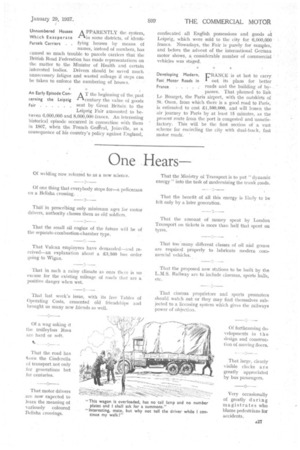Passing Comments O NE of the most satisfactory campaigns conducted by
Page 28

Page 29

If you've noticed an error in this article please click here to report it so we can fix it.
the Safety First Association has been in connection with paid drivers, of whom more than 100,000 are enrolled in the Association's safe-driving scheme, in which they compete for certificates and medals. The recipients of these prize them very highly, and those who have not yet attained honour in this direction display the utmost keenness in their efforts towards success, thus the competition has becoine an important factor in the promotion of safe driving.
More Than 100,000 Drivers in Safety Competition . . .
A Time honoured A MOST ingenious solution to Autorn3bile Problem 1-1 the problem of engaging
Cleverly Tackled . the drive between engine and
wheelswithout power loss has been submitted to us. It is an attachment for use under only exceptionally severe conditions, and gives a positive drive of a ratio rising progressively from infinitely low to that of the normal first gear. It has been patented by Mr. A. F. Kent, Lee Moor, Cornwood, Devon, who would like to hear from any manufacturer interested. His scheme is to provide a crossshaft behind the gearbox, driven by a suitable gear and a dog clutch, which also breaks the main (hive. This shaft has a narrow deeply flanged drum at each end. Similar larger-diameter drums are provided on
A26 the rear wheels. A cable is attached to each pair in such a way that it can be wound on one drum—coil upon coil—as it unwinds from the other, the effective diameters changing during the process. For starting, the cable is fully unwound from the driving drum. When the ratio has risen to the maximum, the dog is automatically shifted and the driven drums disengaged. Springs then rewind the cable.
Licensing Barometer HE adaptability of the
Shows Virile State of I commercial-motor industry, the Industry. . . despite legislative interference
and the efforts of the railways to stampede operators, is well reflected in recent licensing returns. In thepast four years, ended November 30, the number of licences current for goods vehicles was as follow :-1933, 379,592; 1934, 393,128; 1935, 420,004; 1936, 445,825. In 1922, the total was 158,856, so that, on the face value of figures alone, the virility of the industry cannot be questioned. On the passenger-carrying side other forces have been at work, but, for all that, a state of stability appears to haiie been reached, as these licensing figures, for the same years, clearly suggest :-1933, 73,022; 1934, 73,260; 1935, 72,867; 1936, 72,818. In 1922, the total was 72,263, so that quiet progress is apparent in this sphere, although it is certainly not spectacular.
Unnumbered Houses A PPARENTLY. the system,
Which Exasperate in some districts, of identi Parcels Carriers . fying houses by means of names, instead of numbers, has caused .so much trouble to parcels carriers that the British Road Federation has made representations on the matter to the Minister of Health and certain interested bodies. Drivers should be saved much unnecessary fatigue and wasted mileage if steps can be taken to enforce the numbering of houses.
An Early Episode ConA 1' the beginning of the past cerning the Leipzig 1–I-century the value of goods
Fair sent by Great Britain to the Leipzig Fair amounted to between 6,000,000 and 8,000,000 francs. An interesting historical episode occurred in connection with them in 1807, when the French Gedtral, Joinville, as a consequence of his country's policy against England,
confiscated all English possessions and goods at Leipzig, which were sold to the city for 6,000,000 ' francs. Nowadays, the Fair is purely for samples, and before the advent of the international German motor sh6ws, a considerable number of commercial vehicles was staged.
Developing Modern, r RANCE is at last to carry Fast Motor Roads in I out its plans for better France roads and the building of bY passes. That planned to link Le Bourget, the Paris airport, with the outskirts of St. Ouen, from which there is a good road to Paris; is estimated to cost £,1,500,000, and will lessen the air journey to Paris by. at least 15 minutes, as the present route from the port is congested and unsatisfactory. This will be the first section of a vast scheme for encircling the city with dual-track, fast motor roads.




















































































